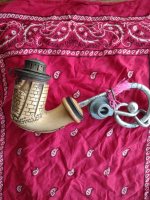Late 1800s & early 1900s was the golden age of pressed meerschaum.
Much less is made today than was made then. Ben Rapaport writes extensively on its history in "Collecting Antique Meerschaum Pipes," a really wonderful book, with words from people at the time talking about what was added to the mix, and how it was always imperfect because you couldn't keep dust from getting in, too. The reprints of antique Sears catalogs list a lot of pipes, and about half the meerschaums are 'block,' the other half 'chip.' Some of those list these lap pipes, and the ones with carved scenes are
always listed as chip and as being "antique-style." It was around in the 1940s and 1950s, too, and you'll see it in catalogs from that era; by that time, they were being made in Austra and Turkey, and the catalogs say which are block and which are pressed. Hit Wishbook Web and look at some mid-century Christmas catalogs, which still had a small selection of pipes.
I've never heard of pressed coming about
after and because export of uncarved meerschaum was illegal. Where did that rumor come from? Turkey prooduces all the pressed meerschaum available today; there's very little of it and it's mostly for the cheap mini-size pipes. I don't know of anywhere else producing meerschaum pipes, pressed or otherwise, after that law change, save the African meerschaum, which was mined there. That was block, but far less porous, hence the calcining, coloring process usually done to it.
Actually, I went ahead and looked. Examples:
This 1902 Sears catalog page is unfortunately only the 2nd of two pages, the other not shown. I have one of the reprints of this entire catalog (or most of it, anyway; if the original had ten pages of something, say, pianos, the reprint only copied two or three of them). Note the first pipe at top right is 'chip.' On the other page, there were three more amidst lots of briar. I can't seem to locate mine at the moment, but the 1908 reprint shows about 40 meerschaum pipes, and over half are 'chip.' A few say 'Vienna meerschaum' instead, which was slang for pressed at that time; pipes that were block meerschaum said either 'genuine block meerschaum' or just 'genuine meerschaum.'
In 1948, both of Sears' meerschaums were Turkish, one pressed, one block. Long before export was banned, Turkey was producing pipes, mostly in traditional Briar shapes like Austria was making then.
A collection of US retail Seasonal Catalogs & Christmas Holiday Wishbooks
christmas.musetechnical.com
Sears Christmas 1950 with Austrian block & Turkish pressed.
1950 Sears Christmas Book, Page 50 - Catalogs & Wishbooks - https://christmas.musetechnical.com/ShowCatalogPage/1950-Sears-Christmas-Book/0050
In 1959, export of raw block was still legal. Yet Montgomery Ward's block is Turkish. "Vienna meerschaum" was slang for pressed, and those could be European or Turkish; by the style of the two-pipe set's case, these were European-made. Turkey never produced those push clasps, only the folding type (an easy way to ID a Turkish pipe by its case).
A collection of US retail Seasonal Catalogs & Christmas Holiday Wishbooks
christmas.musetechnical.com
Sears in 1964 was offering "molded Vienna" meerschaums and one block; again, the block meerschaum's case is definitely European, so this must have been just before that law change, which was in the mid- to late-1960s.
A collection of US retail Seasonal Catalogs & Christmas Holiday Wishbooks
christmas.musetechnical.com





















